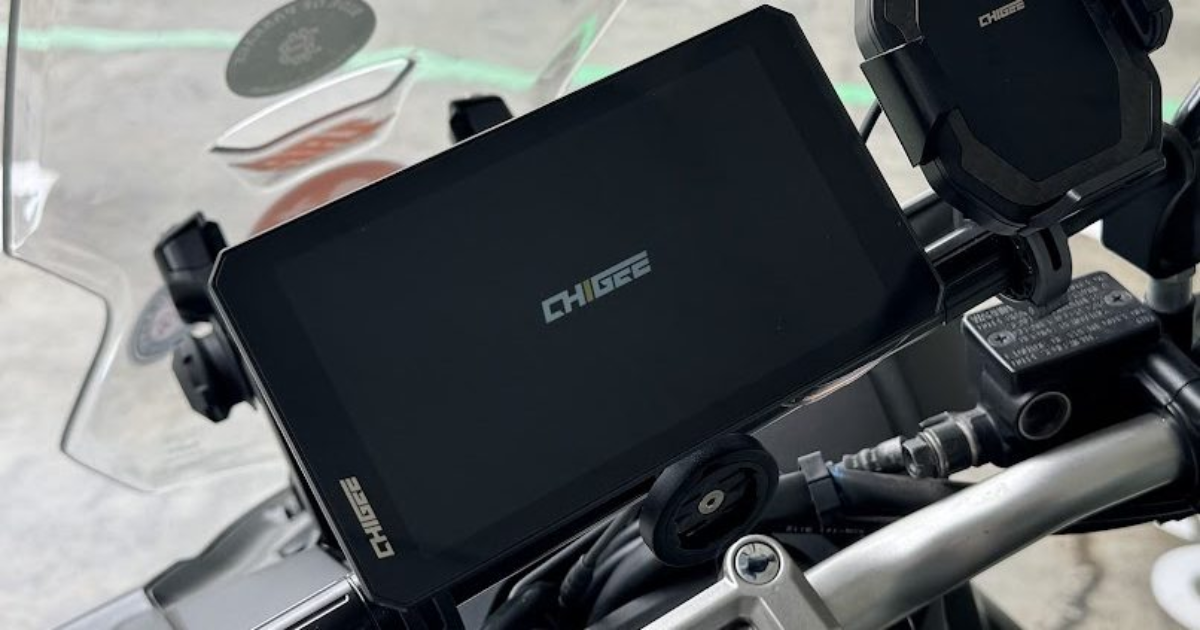
Best Motorcycle Helmet Cameras from Action to Dashcam
left for contents
Motorcycle helmet cameras… they’re not just toys for adrenaline junkies anymore. They’re your eyewitness on the road, your storytelling sidekick, and maybe, just maybe, your ticket to internet fame. But here’s the thing nobody tells you straight up:
- Most helmet cam footage is boring. Yep, harsh but true. Just strapping a camera on and riding doesn’t automatically make for captivating content. 360 cameras like the Insta360 X5 solve this to some extent just by giving you more shots to choose from.
- The “best” camera is different for every rider. It’s all about what you need, not what some tech reviewer says is the top of the line. Making ride videos vs capturing potential accidents call for two very different setups.
- GoPro is no longer the king. The company that defined the action camera category doesn’t even make this list – plagued by battery problems, constant freezing / crashing and camera sensors that just can’t keep up with Insta360 and DJI’s offerings.
- Mounting can be a headache. Get ready to wrestle with sticky pads and straps that look like they were designed by a caffeinated spider. We’ll cut through all the junk below (motorcycle-mounted cameras are easier).

Intrigued? Good. Because by the end of this article, you’ll not only understand why I just dropped those truth bombs, but you’ll be armed to choose the perfect helmet camera for your ride, your style, and your budget. Let’s get rolling.
Which Helmet Camera is Right for You? It Depends…
Just like bikes, cameras aren’t one-size-fits-all. Are you a weekend warrior carving canyons? A daily commuter battling traffic who wants to record in the event of a crash? Or a motovlogger chasing internet stardom? Your riding style dictates your camera needs.
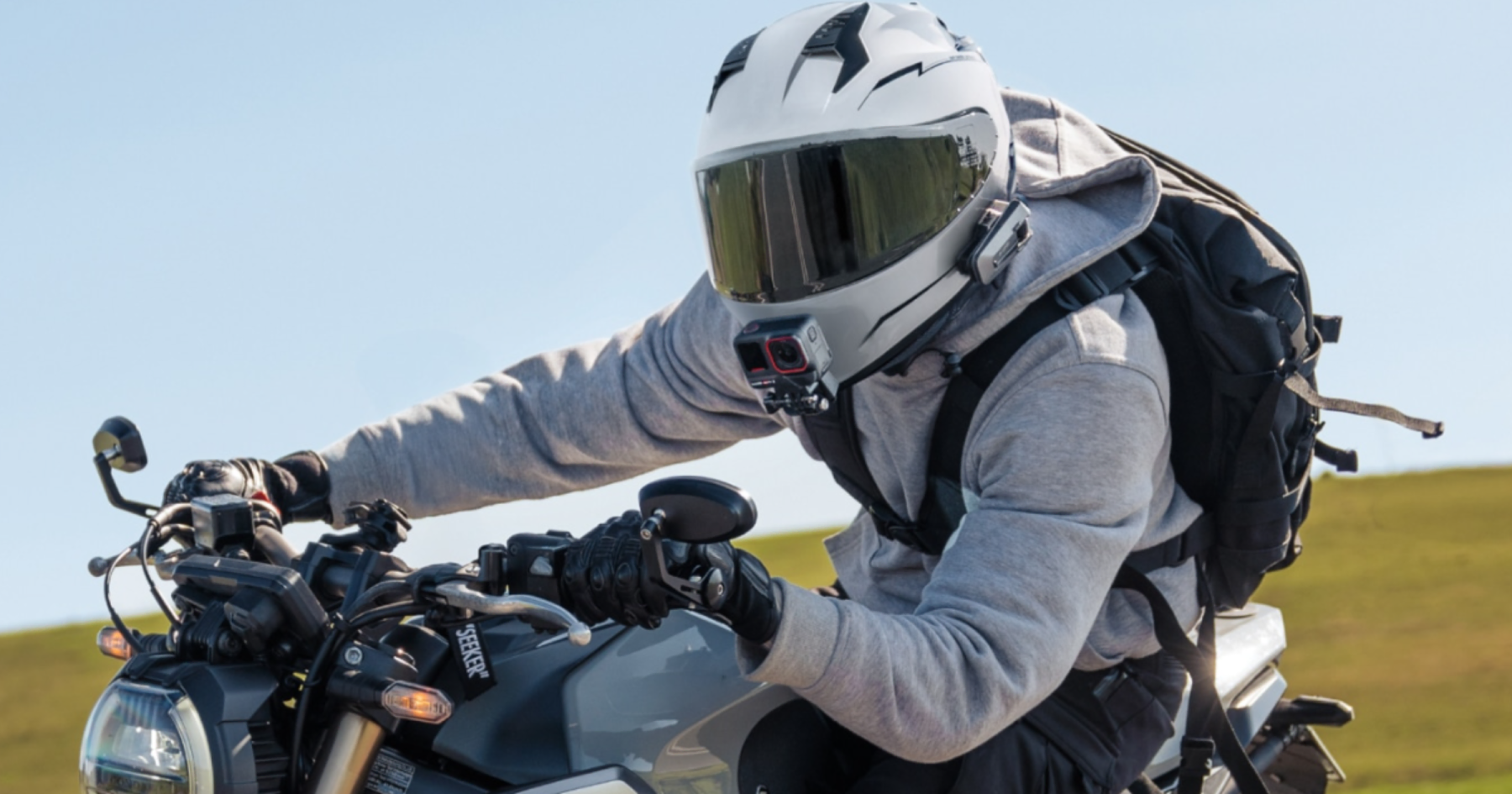
- For the Everyday Rider/Commuter: You need something reliable, easy to use, and maybe with safety features in mind. Think clear footage for insurance purposes, good battery life for the daily grind, and simple controls you can manage with gloves on.
- For the Adventure Junkie/Off-Roader: Durability is king. Your camera needs to withstand dust, mud, rain, and definitely a tumble or two. Stabilization is crucial for bumpy trails, and battery life for long days off the grid.
- For the Motovlogger/Content Creator: Video quality is paramount. You’re chasing cinematic shots, crisp audio, and features that make editing a breeze. 360 capabilities, excellent stabilization, and external mic support might be on your wishlist.
Let’s dive into some cameras that nail these different scenarios.
Insta360 Ace Pro 2: Best Image Quality
Best for: The best image quality for all types of riders wanting to capture their ride in a traditional action cam format.
The Insta360 Ace Pro 2 isn’t playing around – it is going for GoPro’s jugular. This camera is gunning for the action cam crown, boasting some serious tech in the light balancing, low light and stabilization departments to set it apart.
While Insta360 is known for it’s 360-degree cameras like the X4 (we’ll get to that later) that grab everything, the Ace Pro 2 aims to capture clarity and detail, especially when the light gets tricky.
The Insta360 Ace Pro 2 is an advanced 8K waterproof action camera co-engineered with Leica for superior imaging and low-light performance.
Ultimate Bundle Includes
The 8K waterproof action camera, multiple batteries, a fast charger, a lens guard, a selfie stick, a mounting kit, and other essential accessories for an all-in-one motovlogging or adventure setup.
- 8K video with Leica optics and dual AI chips for enhanced quality
- PureVideo mode for exceptional low-light performance
- Wind Guard technology for improved audio clarity
- Premium Price
- Not the longest battery life
The Breakdown:
- Mind-Blowing Low-Light Performance: This is the Ace Pro 2’s killer app. It sports a larger 1/1.3″ sensor and a dedicated AI chip designed to make night rides look like daytime (almost). Expect cleaner footage in dusk, dawn, and even under streetlights. For riders who log miles before sunrise or after sunset, this is a huge advantage.
- 4K 120fps Video: Capture super smooth slow-motion in glorious 4K. Highlight those knee-down moments or trail riding jumps with buttery smoothness. The high frame rate is also great for general action capture, giving your videos a professional polish.
- “Pure Video” Mode: This mode leverages the AI chip to reduce noise and boost detail, especially in low light. It’s like having a built-in video enhancer that works its magic in real-time. Reviewers rave about the improved dynamic range and clarity this mode provides.
- Horizon Lock: Keep your horizons level, even if your helmet is bouncing around. This feature is crucial for motorcycle footage, ensuring your videos don’t induce seasickness.
- “Clarity Zoom”: Digitally zoom in without losing detail, thanks to that beefy sensor. Punch in on points of interest without your footage turning to mush.
- Flip Screen: A vlogger’s best friend. Frame yourself perfectly when talking to the camera, or easily check your shot while handlebar-mounted.
- Action Ready: It’s waterproof, shockproof and stabilized as you’d expect from an action camera.
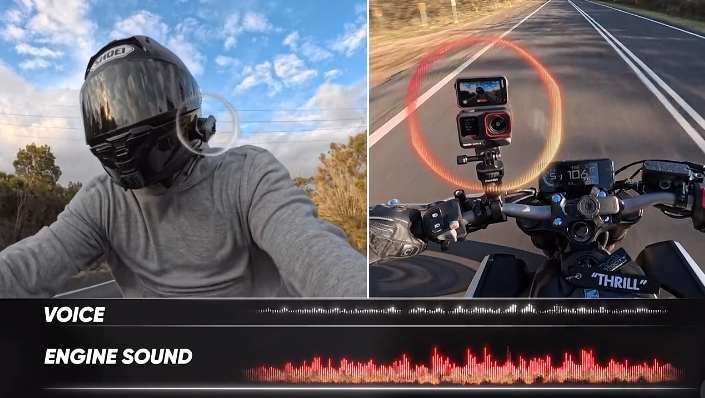
Downsides and Alternatives:
- Price: Top-tier tech comes at a price. The Ace Pro 2 is positioned as a premium action camera, putting it head-to-head with GoPro. Probably overkill if you just want to record in the event of a crash – something like the Go 3S or a bike-mounted system might work better.
- Battery Life (vs. Osmo Action 5): While improved from the original Ace Pro, battery life is still not class-leading at about 1.5 hours in ideal conditions, especially when pushing high frame rates and using Pure Video mode. That’s compared to DJI’s stunning 4 hours of battery life with the Osmo Action 5. Silver Lining: Fast charging gets you back in action quickly, and you can power the camera externally – like via a USB charging port on your bike.
Mounting: The Ace Pro 2 uses the standard action camera two-prong mount, making it compatible with GoPro-style mounts. You’ve got a massive ecosystem of options for helmet, bike, and body mounting.
DJI Osmo Action 5: Best Battery Life
Best for: Long-haul riders, adventure touring, those who value battery life above all else, and users already in the DJI ecosystem.
DJI is known for drones and gimbals, and their Osmo Action line brings that expertise to action cameras. The Osmo Action 5 is all about endurance and ease of use.
DJI Osmo Action 5 Pro is a rugged 4K action camera built for stunning footage, even in extreme conditions.
- Crisp 4K/120fps with top-tier stabilization
- Dual OLED screens for easy control
- Up to 4-hour battery life
- DJI Mimo editing app not on Google Play
The Breakdown:
- Epic 4-Hour Battery Life: Four hours! Let that sink in. That’s a full day of riding for many of us, all on a single charge. Forget battery swaps and power banks – the Osmo Action 5 Pro is built for marathons, not sprints. For adventure riders and tourers, this is a huge plus. And, DJI offers Extreme Batteries designed for sub zero temperatures, and a battery case that functions as a fast charger for those batteries (not available for the 5 yet, but hopefully coming soon)
- 4K 120fps Video with HorizonSteady 360°: Yes, it shoots stunning 4K at a super smooth 120fps for epic slow-mo. But the real kicker is the 360° HorizonSteady stabilization. That locks the horizon to show off your lean.
- Built-in 47GB Storage: Running out of SD card space mid-ride? You have some breathing room. The Osmo Action 5 Pro has a whopping 47GB of internal storage to back you up. Extra peace of mind, and super convenient for quick grabs without needing to swap cards.
- Dual OLED Touchscreens (Front & Rear): Crystal-clear OLED screens front and back for perfect framing, no matter which way you’re facing. The front screen is especially brilliant for handlebar-mounted vlogging.
- DJI Mic Integration: Seamlessly connect DJI Mics for pro-level audio. If you’re serious about motovlogging sound, this is a huge advantage, streamlining your audio setup and ensuring top-notch quality.
- Intelligent Subject Tracking: The Osmo Action 5 Pro can intelligently track subjects, so you can capture your buddy from behind even when you’re weaving through traffic or hitting bumpy trails. DJI’s practice in the drone game applies to their cameras as well.
- Action Ready: It’s waterproof (up to 20 meters), shockproof and stabilized – everything you expect from an action camera.
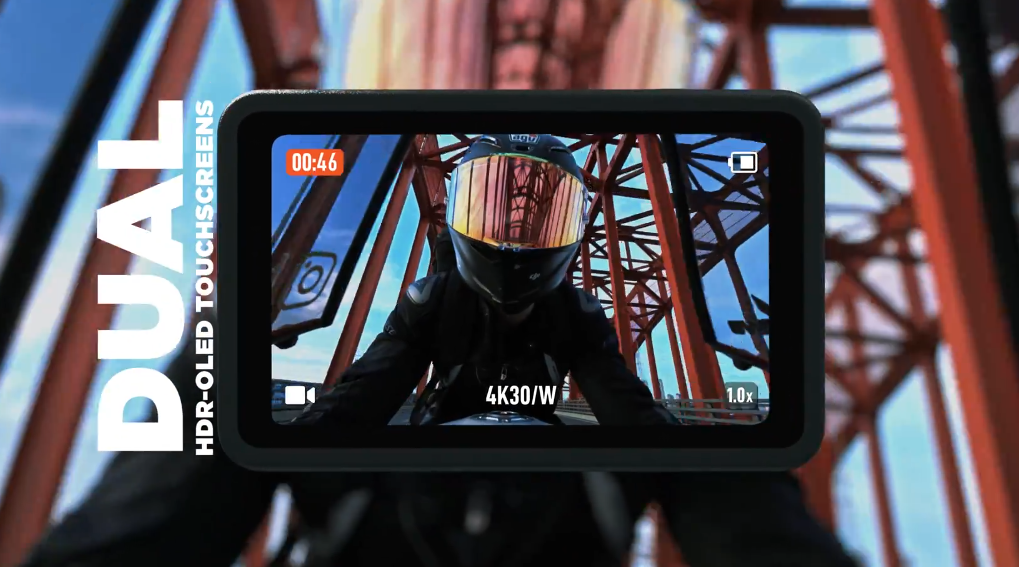
Downsides and Alternatives
- Low-Light Performance (vs. Ace Pro 2): While the Osmo Action 5 Pro’s low-light is good, it doesn’t reach the AI-enhanced levels of the Insta360 Ace Pro 2 in extreme darkness.
- Price: If the Osmo Action 5 is too much for you, check out the older Action 4 and Action 3 models – they’re still great cameras that offer a budget-friendly entry point into the DJI ecosystem, though with less impressive battery life and features.
- Size/Weight: Packing in that massive battery and internal storage might make the Osmo Action 5 Pro slightly larger or heavier than some competitors. But that could be worth it for you given how long that battery life is. Alternative: Insta360 GO 3 is the smallest and lightest option, though with significantly different features and battery life.
Mounting: The Osmo Action 5 Pro uses DJI’s magnetic mounting system, which is incredibly quick and convenient. It’s also compatible with standard action camera mounts via an adapter (included), giving you tons of flexibility.
Sena 50C: Best for Ease of Use
Best for: Riders who don’t want another device hanging off their helmet.
The Sena 50C is more than a camera, it’s a motorcycle comms device. And while I’m a bigger fan of Cardo for comms, I can appreciate the 50C if you don’t want another device hanging off your helmet to capture your rides and use comms.
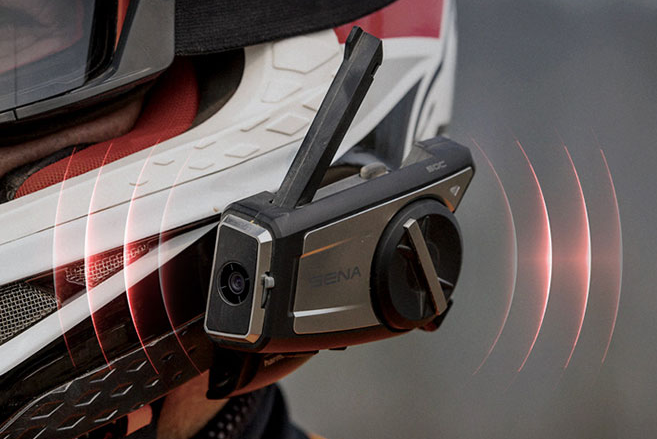
So Sena squashed a top-of-the-line 50S Bluetooth and Mesh communicator and a 4K action camera into one device that slides on to the side of your helmet.
This has some benefits – allowing better control of footage capture, for instance, with voice commands.
All‑in‑one helmet comm and 4K camera with Mesh Intercom 3.0 and Harman Kardon sound—captures every ride while keeping you connected and crystal-clear on the go.
- Mesh 3.0 ensures seamless group comms across long distances
- 4K camera captures high-resolution video and stills
- Harman Kardon audio delivers clear music and call quality
- Voice commands (“Hey Sena”) let you control camera hands‑free
- Firmware setup and app integration can be finicky at launch
- Wi‑Fi reconnects may drop video occasionally during riding
The Breakdown:
- Integrated 4K Camera and Communication: Clean helmet setup. One device for talking and filming. Makes capturing group rides super simple, and allows for voiceover in motovlogs without any extra messing with microphones.
- Sena Mesh 2.0 Intercom: Rock-solid communication with a huge range (over a mile between each of virtually unlimited riders) and crystal-clear audio. Speakers and microphone designed by Harman Kardon, so you know it’s bumpin’.
- 4K Video Recording: Sharp, detailed video at 30fps. Not quite the 120fps of dedicated action cams, but for simple recording of rides or motovlogs it’ll do.
- Voice Commands: Control the camera and comms with your voice. “Hey Sena, start recording.” Hands-free operation is a huge plus on a bike. Voice commands work in 8 languages too.
- Bluetooth 5.0: Fast, stable connection to your phone for music, calls, and app control.
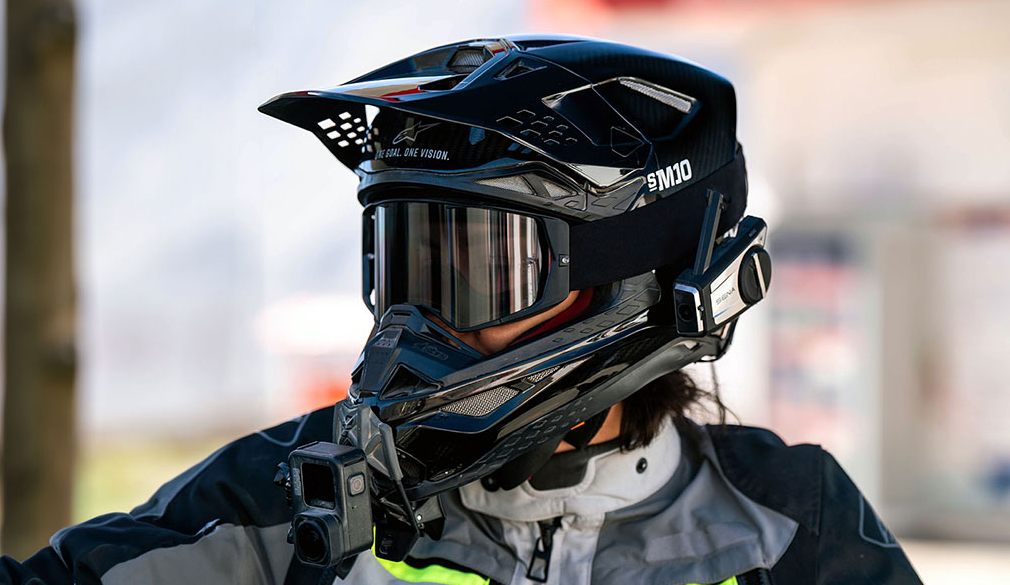
Downsides and Alternatives
- Price: Integrated tech comes at a premium. You’re going to pay about as much for this as you would for an equally capable Sena 50S with a standalone action camera that’s only one generation older than the newest (like the DJI Osmo Action 4). But you get the convenience and sleekness of having it all in one device.
- Camera Specs Not Top-Tier: The 4K camera is good, but not class-leading in video quality or features compared to dedicated action cams. If camera quality is your absolute top priority, a dedicated action camera will offer more features and better image quality plus stabilization.
Mounting: The Sena 50C integrates directly onto the side of any motorcycle helmet, with the speakers and microphone mounted inside. It’s designed for seamless integration, minimizing bulk.
Our Review: We haven’t reviewed the Sena 50C specifically, but we have compared Senas to other communication devices on the market. Check out our Comms section!
Insta360 X4: Easiest to Capture
Best for: Motovloggers, creators, those wanting maximum perspective or “set and forget” recording.
This isn’t a helmet camera – it’s better.
If you haven’t tried a 360 camera yet, you’re missing out. Insta360’s signature camera’s really break everything you think you know about capturing a ride. Forget about aiming – this thing records everything around you in glorious 5.7K at 60fps. Then you can choose in production which angles you want to focus on when, and whether you want a fisheye look or a normal linear one.
Editing is simple too: use Insta360s own video editor, or use the plugin with Adobe Premiere Pro to manipulate your 360 footage however you like. I’ve done it a bunch and so has our in-house video editor at It’s Better On The Road – both novice and professional can handle it.
The Insta360 X4 is a powerful 8K 360 action camera designed for immersive and ultra-stable video capture.
Included in the Bundle:
Motorcycle Bundle includes the camera, lens guards, Invisible Selfie Stick, clamp and 256gb SD card. You're gonna want more batteries, or plug in to your bike!
- Stunning 8K 360° video with AI-powered reframing
- Invisible Selfie Stick effect for dynamic third-person shots
- Advanced stabilization with FlowState and Horizon Lock
- Get the right bundle - Motorcycle Bundle recommended. Selfie Stick not available with standard bundle.
The Breakdown:
- 5.7K 360° Video at 60fps: Crisp, detailed footage that looks pro. The 60fps is key for smooth slow-motion shots, perfect for highlighting those riding moments.
- “Invisible Selfie Stick” Effect: Mount it right off your bike, and in your videos the stick magically disappears. It’s like drone footage without the drone hassle. This is gold for motovlogging – clean, immersive shots that put viewers right in the scene.
- Reframing Magic: This is where the X4 shines. Shoot first, point later. Missed that deer darting across the road? Reframe in post. Want to change the angle or shot style for different platforms (YouTube vs. TikTok)? Reframe. It’s editing freedom on steroids.
- Improved Ruggedness: Insta360 listened to riders. The X4 is tougher, ready for more demanding rides. While not indestructible, it’s built to handle the bumps and splashes of motorcycle life. I have the X2 and I’ve put it through a lot – the lens is truly difficult to scratch, and you can buy protective covers for it.
- FlowState Stabilization: Insta360’s stabilization is legendary, and the X4 is even better. Bumpy roads? No problem. Your footage stays buttery smooth, which is crucial for watchable motorcycle videos.
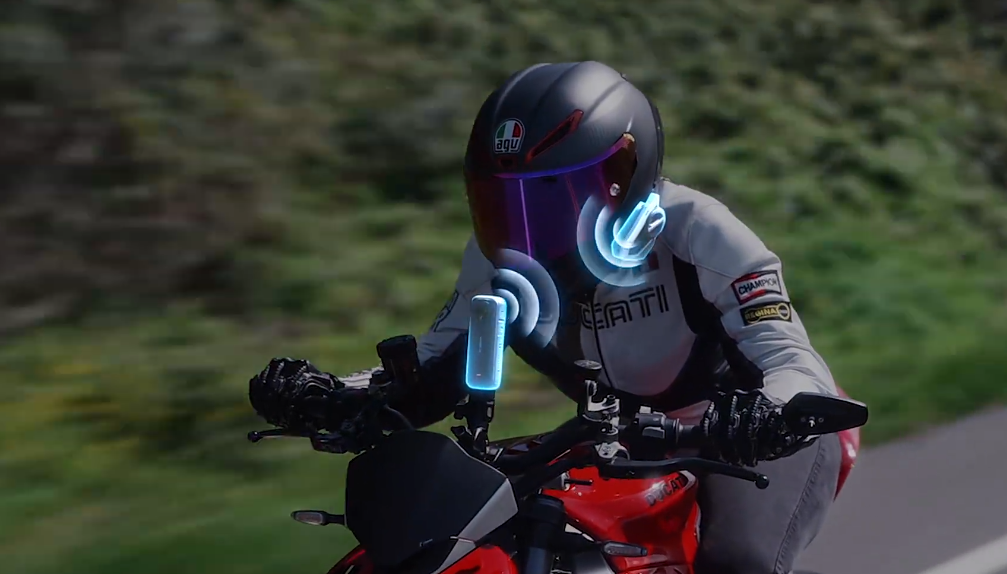
Downsides and Alternatives
- Price: 360° magic comes at a cost. The X4 is pricier than standard action cams, but you’re also capturing what would take 6 cameras to achieve. One camera, endless angles. The Insta360 GO 3 is smaller and cheaper, still offering 360 capture, though with slightly lower specs.
- Battery Life: The battery only lasts 60 minutes, which for a ride is pretty short. That said you can charge it off your bike while you ride, which I’ve done and works like a charm for unlimited recording.
- Editing Learning Curve: Reframing 360° footage takes a bit of practice, but like I said, achievable even for a novice. Insta360’s software is user-friendly, and the creative possibilities are huge.
Mounting: The X4 plays nice with any mount thanks to the industry-standard 1/4inch screw mounts Chin mounts, side helmet mounts, even handlebar mounts – you’ve got options. The “invisible selfie stick” is best for that floating perspective.
Our Review: I use an Insta360 X2 regularly and have tried the X4, but haven’t put out a review yet. Editing takes some time to get used to, but the footage and ability to capture any angle is amazing.
INNOVV K5: Motorcycle Dash Cam
Best for: Commuters and riders who want to always record their rides to cover themselves in the case of a crash.
The INNOVV K5 is different from the rest – it’s not an action camera, and its focus is not on image quality. It’s designed like a dashcam – an always-on witness, constantly recording your rides for safety and security. Rather than mounting to your helmet, it mounts in your bike itself, recording the front and rear while saving the recording on-device in a loop.
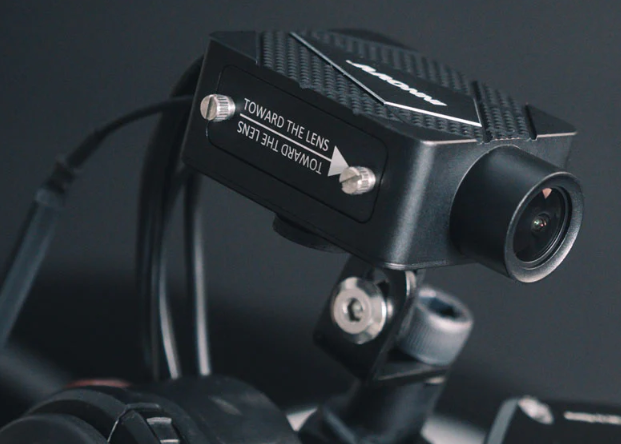
INNOVV also have motorcycle dash cams that mount to your bike and use your motorcycle’s power to always record, usually front and back. You can find their K5, K6, and K7 dash cams at various price points here. The H5 we’re talking about here is helmet mounted.
A high-quality 4K front and 1080p rear dash cam with dual-band Wi-Fi, GPS, and waterproof durability for any ride.
- Clear 4K front and 1080p rear recording
- Always on recording, built in to your bike.
- Smart remote control and mobile app with customizable recording setup
- Stabilization and night view not as clear as DJI and Insta360 options
- 4K Front Camera and 1080p Rear: Crystal-clear footage from both front and rear perspectives to capture license plates, road signs, and any details you’d want in an incident. Two cameras Gives you almost complete coverage of what’s happening around your bike.
- Powered by the Bike: THe unit connects to your bike’s battery, so when your bike is on, it’s on.
- Automatic Loop Recording: Records continuously, overwriting old footage. Set it and forget it – the system is always recording whenever your bike is on. Ensures you never miss an incident, and you don’t have to constantly manage storage space.
- Impact Detection (G-Sensor): Built-in G-sensor detects sudden impacts (like accidents) and automatically locks and saves the relevant footage, preventing it from being overwritten by loop recording. Critical incident footage is protected.
- Dedicated Control Unit: The K5 features a small handlebar-mounted control you can use to snap pictures or save recordings while enjoying your ride.
- GPS Tracking: Built-in GPS logs your speed and location data, embedding it into the video footage. This can be invaluable in case of disputes or insurance claims, providing verifiable data about your ride.
- Weatherproof and Rugged System: Designed for motorcycle use, the entire K5 system (cameras, DVR, wiring) is built to withstand rain, dust, vibrations, and temperature extremes.
- Mobile App Connectivity (Wi-Fi): Connect to the DVR via Wi-Fi using a smartphone app to review footage, adjust settings, and download videos. So you can still grab videos of a nice ride.
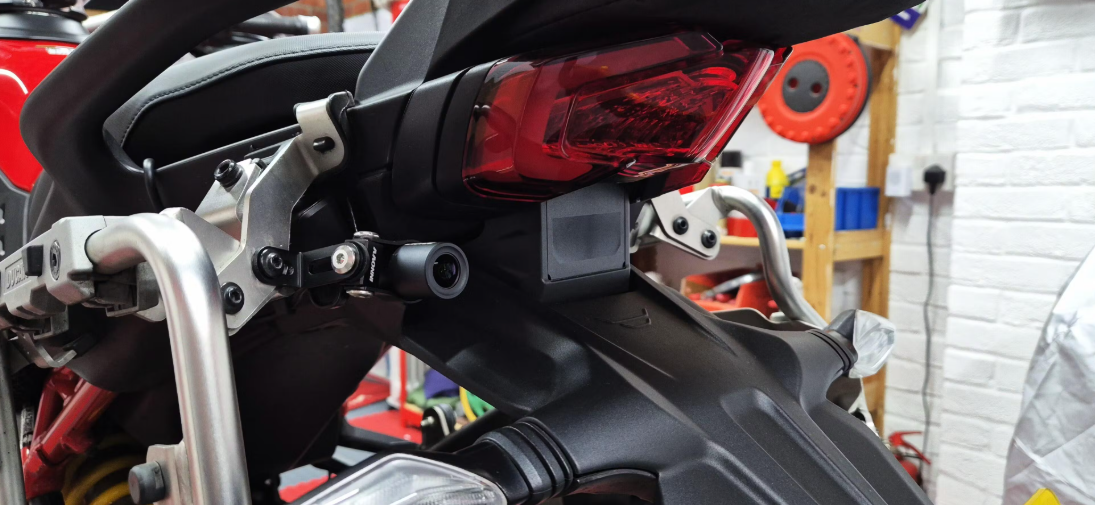
Silver Linings and Alternatives:
- Complex Installation: Setting up the K5 is significantly more involved than mounting a single action camera. Wiring to the bike’s battery, finding locations for two cameras and the DVR unit takes a bit of time and wrenching. But once it’s installed, it’s a “fit and forget” system that operates automatically. No charging, mounting, starting or stopping.
- Video Quality (vs. Top Action Cams): While 4K at the front is decent, this camera is not going to match the flagship action cameras in terms of detail and dynamic range, especially in challenging lighting. So you may want an action camera for making ride videos.
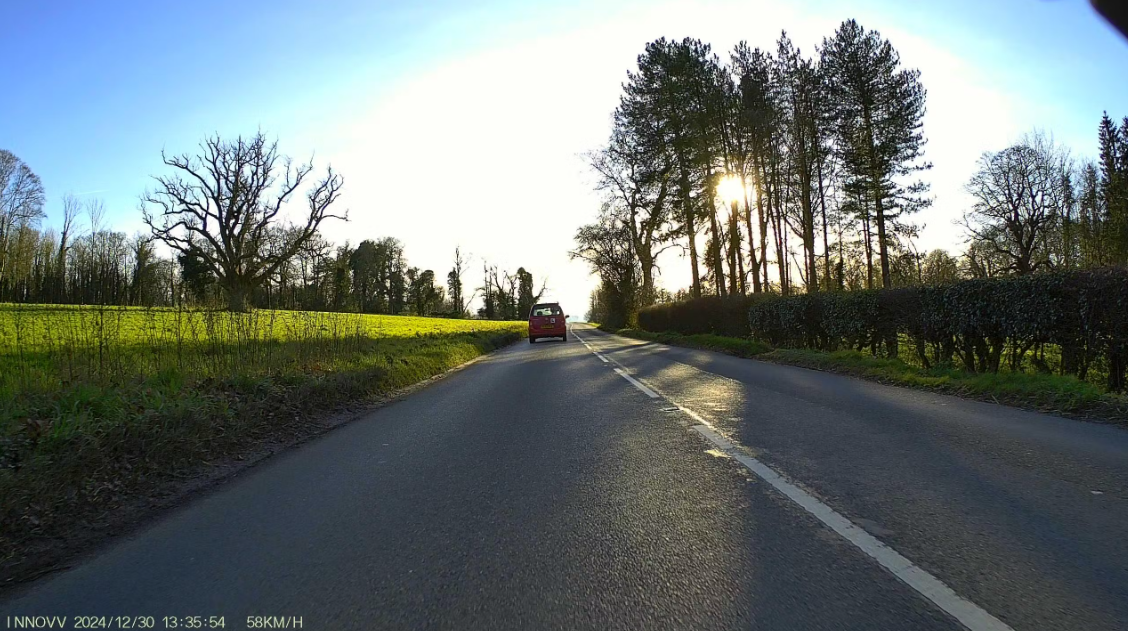
Mounting:
- Camera Mounting: The K5 cameras are designed to be mounted to your motorcycle frame or fairing at the front and rear. The front camera is a small box housing the DVR, while the rear is a compact cylinder allowing for discreet placement. Metal brackets and adhesive pads are included for secure mounting wherever they might fit on your bike. Keep in mind the DVR should be relatively accessible for SD card access, but also protected from the elements and vibrations.
- Wired Power and Connections: Installation involves routing wires from the rear camera to the DVR unit, and then wiring the DVR to your bike’s battery. This is more complex than a simple action camera and requires careful planning and cable management.
In many regions, dashcam footage is admissible as evidence in accidents. Having a multi-camera system like the K5 could be particularly beneficial in documenting incidents from multiple angles.
Buying Guide: Zeroing In On Your Perfect Helmet Cam
Okay, you’ve seen some cameras. But how do you pick the one? Let’s break it down:
Your Riding Style and Needs:
- Commuting/Daily Riding: Reliability, ease of use, loop recording (dashcam function), decent battery life. Consider INNOVV K5, Sena 50C, or DJI Osmo Action 5 with its juicy battery.
- Adventure/Off-Road: Durability, ruggedness, excellent stabilization, long battery life. DJI Osmo Action 5, Insta360 X4 (so you always have the right perspective).
- Motovlogging/Content Creation: Top-notch video quality, excellent stabilization, external mic support, front-facing screen (optional but helpful), 360° capabilities (Insta360 X4). Consider Insta360 X4 (so you can get forward facing shots as well as shots facing you, with one camera!), Insta360 Ace Pro 2 or the Sena 50C (for integrated microphone).
Key Features to Scrutinize:
- Video Resolution and Frame Rate: 4K is the sweet spot now. 60fps is ideal for smooth motion and slow-motion potential. Keep in mind the 5.7K of the Insta360 X4 is over the whole 360 degrees, so it’s more like 4K when looking in one direction – but you do get that reframing flexibility. 1080p (INNOVV K5) is sufficient for dashcam purposes.
- Stabilization: Crucial for motorcycle footage. RockSteady (DJI) and FlowState (Insta360) are both excellent.
- Battery Life: Consider your typical ride length. Dashcams (INNOVV K5) offer continuous power options. DJI Osmo Action 5 leads in battery life. Insta360 may require extra batteries or power banks for longer rides. Keep in mind you can power these devices during usage from your bike.
- Durability and Weatherproofing: Essential for motorcycle use. Look for waterproof ratings and rugged build quality. Everything on this list makes that cut.
- Mounting Options: Think about helmet placement. Chin mounts offer a great POV perspective. Side mounts are less obtrusive. Consider the camera’s mounting system and accessory availability.
- Audio: Built-in mics are okay for basic capture, but external mic support is a must for serious motovlogging. Sena 50C integrates audio directly with comms in your helmet, and DJI works seamlessly with DJI’s own (incredibly good) microphones.
- Ease of Use: Can you operate the camera with gloves on? Is the interface intuitive? Voice commands are a bonus.
Camera Comparison Table
| Feature | Insta360 Ace Pro 2 | Insta360 X4 | Sena 50C | DJI Osmo Action 5 | INNOVV K5 |
| Best For | Low-Light Performance | Motovlogging, Creative | Comms & Camera | Battery Life | Safety/Dashcam |
| Video Resolution | 8K 30fps, 4K 60fps HDR | 5.7K 360° 60fps | 4K 30fps | 4K 120fps | 4K Front / 1080p Rear |
| Stabilization | AI-Powered Stabilization | FlowState | EIS | RockSteady 3.0+ | Basic |
| Battery Life | Dual Battery for Extended Use | Moderate | Moderate | Excellent | Continuous (Loop) |
| Durability | Rugged, Waterproof | Rugged | Integrated Helmet | Rugged, Waterproof | Weatherproof |
| Mounting | Versatile | Versatile | Integrated | Magnetic | Helmet-Specific |
| Audio | Superior Audio, AI Noise Reduction | Built-in, Ext Mic Opt | Integrated Comms | Built-in, Ext Mic Opt | Built-in |
| Unique Feature | Leica Optics & Dual AI Chip | 360° Capture | Integrated Comms | Long Battery Life | Continuous Recording |
| Get One | Check Price | Check Price | Check Price | Check Price | Check Price |
Are Helmet Cams Legal in the USA?
The short answer: Generally, yes, but with caveats.
There are no federal laws in the USA specifically banning helmet cameras when riding a motorcycle. However, state and local laws can vary, and often relate to obstruction of view.
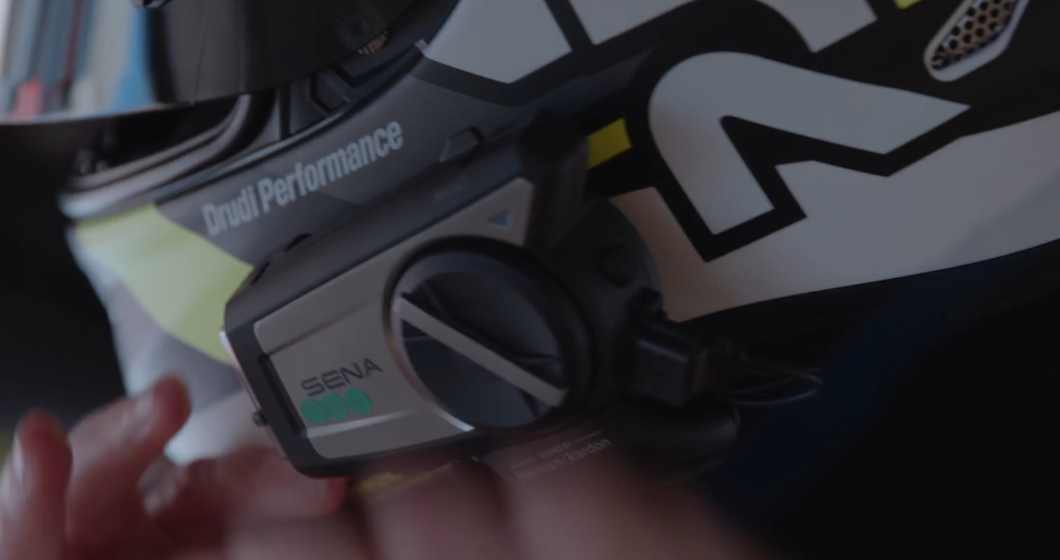
Key Considerations:
- Obstruction of View: Laws prohibit obstructing a rider’s vision. Large or poorly placed cameras could be considered a violation. Keep your camera mounted relatively low-profile and out of your direct line of sight. Chin mounts still give that first person look, and naturally lead to a better sensation of speed and riding than top-mounted camera angles. Just don’t be an idiot and mount in front of your eyes – that’s when you’re gonna get pulled over.
- Audio Recording: “Wiretapping” or eavesdropping laws exist in some states regarding audio recording without consent. This is more relevant if you’re recording conversations with other people, less so for simply recording your ride audio.
- Privacy: Be mindful of privacy concerns when recording in public places. Generally, recording in public is legal, but be respectful of individuals’ privacy.
Disclaimer: I am not a lawyer, and this is not legal advice. Always do your own research and consult with legal professionals if you have specific legal questions.
Mounting Advice for Action Cameras
Mounting your helmet camera might seem simple, but it can be trickier than you think. Here’s the rundown on common methods:
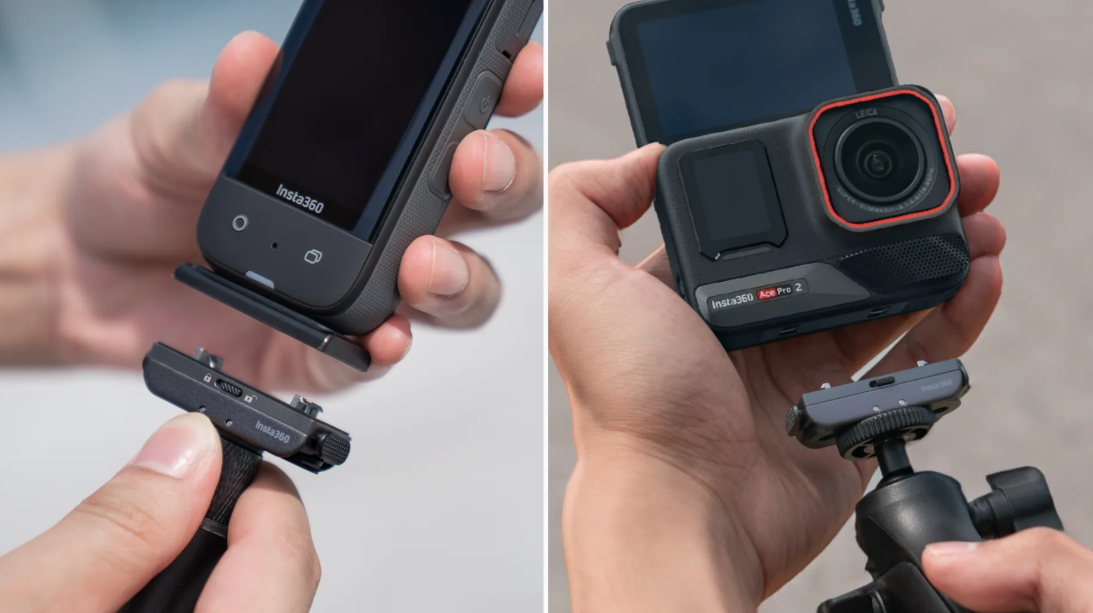
Adhesive Mounts (3M VHB Tape): Sticking a three-prong action cam mount on to the top, side, or chin of a helmet.
- Pros: Very secure, low-profile, versatile placement (chin, side, top). The industry standard for action cams.
- Cons: Permanent (difficult to remove), requires a clean, flat surface, can damage helmet finish if removed improperly.
- Best For: Most action cameras (GoPro, DJI, Insta360). Chin mounts are popular for POV shots. Side mounts are less obtrusive. If you have vents on the chin of your helmet that make a direct chin mount tough, you can also mount slightly to the side and use an extender arm to get the camera to sit directly in front of your chin. This is what I did on my Shoei RF-SR when riding across the USA. .
Strap Mounts: Use straps to attach to your helmet (usually the chin bar) or somewhere else on your bike.
- Pros: Non-permanent, easy to move between helmets, versatile placement (vents, chin bar).
- Cons: Can be bulkier than adhesive mounts, may shift or loosen during your ride, less secure for extreme riding.
- Best For: Experimenting with placement, quickly swapping cameras between helmets, helmets with limited flat surfaces. I have this one and love it.
Clamp Mounts (Handlebar, Mirror Stem): Good if you want a different perspective than just the helmet.
- Pros: Non-helmet mounting options, different perspectives, can be used with various cameras.
- Cons: Less immersive POV than helmet mounts, can vibrate more.
- Best For: Secondary camera angles, capturing bike details, riders who prefer not to mount cameras on their helmets.
I am a huge fan of RAM Mounts for this – at first I balked at the price, but after trying cheaper knockoffs, I am willing to pay their prices for the quality you get. I’ve used their Tough Claws for years through punishing weather and offroad, and never had it move a millimeter. Make sure you get all the parts you need for your setup, like extender arms and action camera adapters.
Adhesive Mounting Tips:
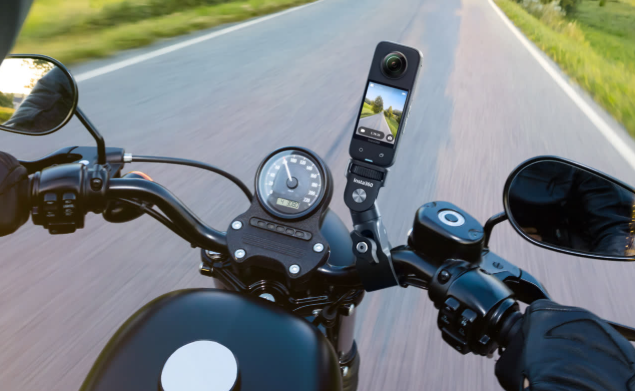
- Clean the Surface: Use isopropyl alcohol to clean the helmet surface before applying adhesive mounts.
- Warm the Adhesive: Use a hairdryer to warm the adhesive tape for better adhesion, especially in cold weather.
- Apply Pressure: Press firmly on adhesive mounts for at least 30 seconds to ensure a strong bond. Leave for 12 hours before you put a camera on it and go for a ride – do not skip this step – seems like overkill but I’ve lost cameras to the excitement of getting on the road before.
- Use Tethers: Always use camera tethers as a backup safety measure, especially with adhesive mounts.
- Test Your Mount: Before a long ride, test your mount at low speeds to ensure it’s secure and doesn’t obstruct your vision.
- Consider Helmet Shape: Some helmets have more curved surfaces than others. Choose mounts that are compatible with your helmet shape.
Related
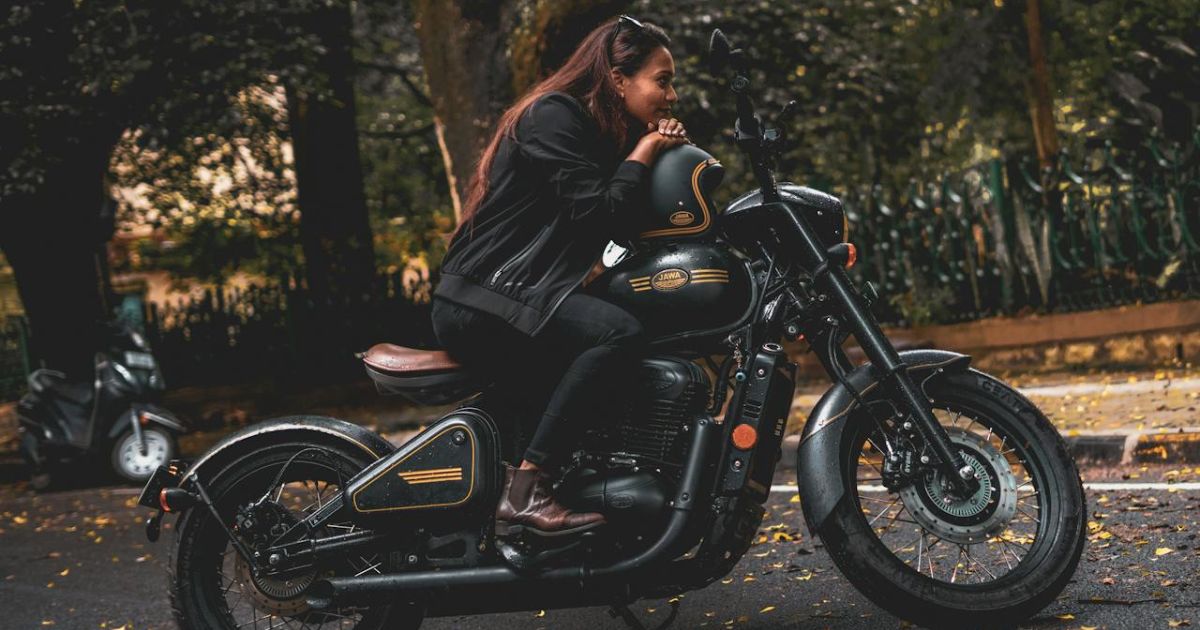
Best Motorcycle Gear for Women: Stylish, Safe & Confident
Discover the best motorcycle gear for women—tested for protection, comfort, and style to keep every rider confident, cool, and safe on the road.







